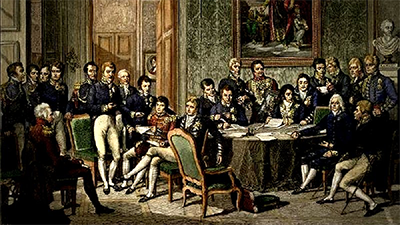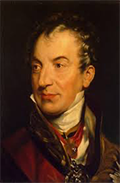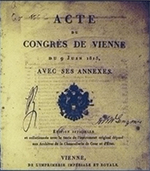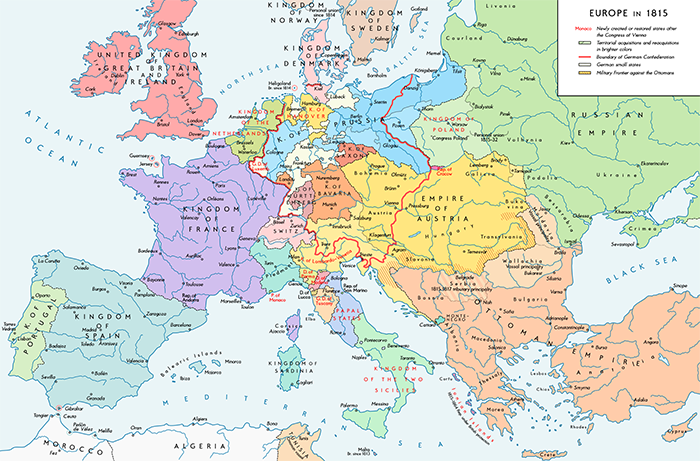The Congress of Vienna
The Congress of Vienna was an agreement between the powers of Europe to reorganize Europe geographically and politically after the Napoleonic Wars. Completed in 1815, it was the most comprehensive yet seen in Europe. A series of wars beginning in the 1790s had pitted Revolutionary France against a series of other European powers in battles of inceasingly devastating cost in both lives and money. The ebb and flow shifted through the years, until the forces arrayed against France in 1814 proved overwhelming. The War of the Sixth Coalition was–with the exception of French Emperor Napoleon Bonaparte's brief return in the Hundred Days, ending at the Battle of Waterloo–the last of these wars. 
Preceding the Congress of Vienna were two other agreements, the Treaty of Chaumont and the Treaty of Paris. Arranging the terms for and signing the former were representatives of the Sixth Coalition: Austria, Prussia, Russia, and the United Kingdom. They met in February 1814, amid the last battles of the War of the Sixth Coalition, and then again on March 1, in the French city of Chaumont, to finalize the terms of the deal. Among the terms of that treaty were that France relinquish all territory taken from other European powers in the past two decades. That would have moved France's borders back to where they were before the French Revolution. Bonaparte refused to do so, and the war continued. After another handful of defeats, Bonaparte abdicated the throne and representatives of the new head of state, King Louis XVIII, brought the war to a close, with the armistice that was the Treaty of Paris, signed on May 30, 1814. Among other things, that treaty restored France's borders to what they were in 1792, when the War of the First Coalition began. Thus, other countries gained (or regained) territory. As well, leaders of the other countries of Europe recognized Louis XVIII as the lawful leader of France. A provision of the Treaty of Paris was that representatives of the powers of Europe would meet again in a few months, in order to discuss a more lasting peace. Thus it was that in July 1814, the Congress of Vienna began. Driving the proceedings were the Four Great Powers (Austria, Prussia, Russia, and the United Kingdom), who had also formed the Sixth Coalition. The high-level representatives of those Great Powers were the following:
Representing France were Foreign Minister Charles-Maurice de Talleyrand and Minister Plenipotentiary the Duke of Dalberg. Talleyrand found himself initially sidelined by the Great Powers but gradually assumed more of a leadership role and played an at times significant part in the negotiations. Representatives of Portugal, Spain, and Sweden were in attendance and had also signed the 1814 Treaty of Paris. Also attending were representatives of:
The Congress was not a formal meeting made up of all representatives. No such meeting took place. Instead, various people met in various groups at various times for many months. Some meetings were official, with pomp amid the circumstances of negotiation. Other meetings were less formal. In all, the negotiations that produced the Congress of Vienna lasted nearly a year, with the Final Act being approved on June 9, 1815. Among the provisions of the Final Act were these:
Allied forces won the Battle of Waterloo shortly after the Final Act was approved, and Bonaparte abdicated for a second and final time. Louis XVIII was again the King of France, and all European powers started the sometimes slow process of rebuilding.
|
|
Social Studies for Kids
copyright 2002–2025
David White



 Austria: Foreign Minister
Austria: Foreign Minister  Austria gained much territory in northern Italy, including Lombardy-Venetia and the Tyrol.
Austria gained much territory in northern Italy, including Lombardy-Venetia and the Tyrol.

